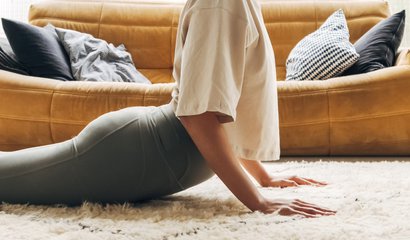April 9, 2025
Unlock Hamstring Flexibility: The Best Stretches and Strengthening Moves
Tight hamstrings are a common struggle. You've stretched, done yoga, and followed every tip the internet has to offer—but they're still tight. And if you're touching your toes while groaning and wondering why it feels tight, you're definitely not alone!
The truth? Hamstring flexibility isn’t just about stretching. It’s about movement, activation, and strengthening. This blog will help you understand why traditional hamstring stretches might not be working for you and introduce key techniques to improve flexibility and mobility in a way that lasts.

Why Are Your Hamstrings Always Tight?
If your hamstrings always feel tight, even after stretching, it could be due to:
- Sitting for long hours – Prolonged sitting shortens the hip flexors and weakens the glutes, making the hamstrings work harder than they should.
- Lack of movement variety – Static stretching alone isn’t enough; your hamstrings need dynamic engagement to function optimally.
- Weak glutes and hip stabilizers – When these muscles aren’t strong enough, the hamstrings compensate, leading to chronic tightness.
- Nervous system tension – The nervous system can restrict mobility if it perceives instability, keeping muscles in a constant state of tightness.
The solution? A combination of movement, activation, and mindful stretching.
The Best Hamstring Stretches and Strengthening Exercises
1. The Movement Reset: Break Up Long Sitting Sessions
Before even thinking about stretching, address one of the biggest culprits of tight hamstrings—extended sitting. Try this:
- Set a timer for every 30-45 minutes to stand up and walk around.
- If possible, switch between sitting and standing throughout the day.
- Incorporate gentle hip mobility exercises to reset your posture.

2. Dynamic Hamstring Wake-Up
Before working on hamstring mobility, let’s take a moment to wake up the nervous system. As tempting as it is to jump into a deep stretch, using gentle movements first helps bring awareness to the legs, hips, and lower body—because our hamstrings don’t work in isolation. Everything is connected.
Flexibility isn’t just about muscles—it’s also about the nervous system. When we move in a way that feels safe and supported, the body is more likely to release tension and allow for greater mobility. This simple step sets the stage for hamstrings that feel not just more flexible, but stronger and more resilient.
- Stand with your feet wide apart.
- Shift your weight side to side, bending one knee at a time.
- Let your inner thighs, hips, and hamstrings engage dynamically.
- Repeat for 30-60 seconds to awaken the muscles before deeper work.

3. Half Forward Fold Activation
Instead of passively stretching the hamstrings, this movement engages and activates them, helping to build flexibility that lasts.
By shifting weight and pressing into the floor, we create strength in length, making hamstring mobility more effective and sustainable.
Part One:
- Stand in a half forward bend with a slight knee bend.
- Press your feet into the floor as if pushing the ground away.
- Engage your thighs and glutes while hinging at the hips.
- Focus on the feeling of lengthening without collapsing into the stretch.

Part Two:
- Shift your weight onto one foot while keeping the hinge position.
- Lift the opposite foot just slightly off the floor, maintaining control.
- Lower the foot back down, then switch sides.
- Repeat 3–5 times per side, focusing on balance and hamstring activation.

4. Elevated Hamstring Activation Stretch
This movement introduces hamstring activation in a lengthened position, helping to build strength and flexibility at the same time. Instead of passively stretching, pressing the foot down into the support engages the muscles, making this a more effective way to improve mobility.
Using a chair, step, or yoga block, this movement helps train flexibility with stability.
- Place one foot on a low surface while keeping a soft knee bend.
- Press your heel into the support while gently pulling your thigh back.
- Focus on activation rather than just depth.
- Repeat on both sides, holding for 20-30 seconds.

5. Hamstring and Hip Rotation Stretch
The hamstrings don’t work in isolation—they connect to the hips and pelvis. Adding rotation can improve overall mobility.
Hip mobility plays a key role in hamstring flexibility. By rotating the thigh inward and outward while keeping the foot elevated, this movement releases tension in the hip joint, improves stability, and allows for greater range of motion in the legs.
- Keep one foot on the stool from the previous movement, standing tall with a soft bend in the knee.
- Rotate your thigh inward and outward, keeping your foot flexed.
- Move slowly to feel the engagement in your hip and hamstrings.


6. Strap-Assisted Resistance Stretch
This movement combines active engagement and resistance to improve hamstring flexibility without passive stretching. Pressing the foot into the strap while pulling back with the hands creates strength in length, helping the nervous system feel safe to allow more mobility.
For deeper activation, use a yoga strap or belt:
- Sit on the floor or a sturdy surface with one leg extended and the other bent for support.
- Gently push your foot into the strap while pulling it towards you.
- Keep a slight bend in the knee to avoid overstretching.
- Hold for 20-30 seconds and repeat on the other side.
Ready to Start Your Yoga Journey?
At Heart and Bones Yoga, starting yoga at home easy and accessible. With beginner-friendly classes, thoughtfully designed programs and a variety of teachers and styles, you’ll never have to guess which class to take. Sign up for our 7-day free trial and explore classes to strengthen your body, calm your mind, and build confidence for life.
How to Incorporate These Hamstring Stretches Into Your Routine
For best results:
- Daily movement is key – Even if you don’t have time for a full routine, move frequently.
- Warm up first – Avoid stretching cold muscles; walk or do light mobility exercises before deep stretches.
- Strengthen alongside stretching – Engaging the glutes and hips will help your hamstrings release tension.
Frequently Asked Questions
What is the best way to loosen tight hamstrings?
Instead of just stretching, focus on movement, strength, and activation. Exercises like dynamic lunges, supported stretches, and strap-assisted activation can provide long-term relief.
How often should I do these hamstring exercises?
Consistency is key. Aim for a few minutes of movement throughout the day and structured exercises at least 3-4 times per week.
Can tight hamstrings cause knee or back pain?
Yes. Tight hamstrings can pull on the pelvis, leading to lower back discomfort, and contribute to knee strain by limiting proper movement mechanics.
When should I see a professional?
If you experience persistent pain, discomfort, or mobility limitations that don’t improve with movement and stretching, consult a physical therapist or healthcare provider for guidance.
By shifting the focus from passive stretching to mindful movement and activation, you can finally improve hamstring flexibility in a way that lasts. Try these techniques, stay consistent, and enjoy the feeling of more mobile, happy hamstrings!



